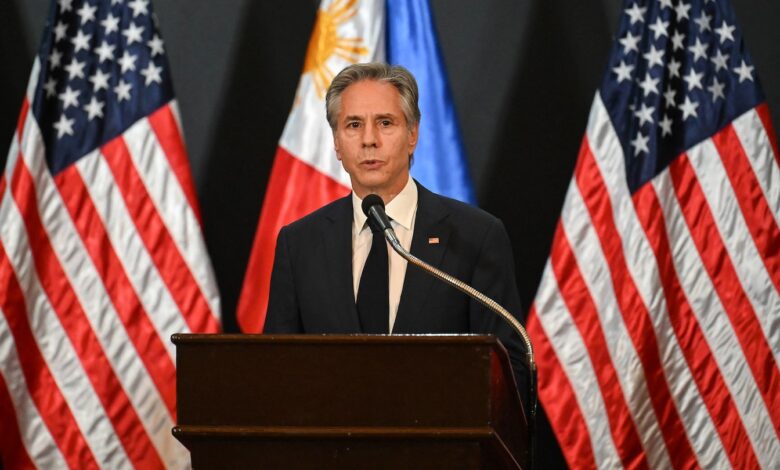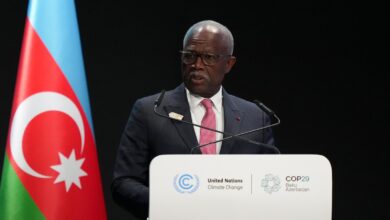U.S., Philippines plan to deepen defense cooperation amid China concerns

Philippine President Ferdinand Marcos Jr. has moved Manila sharply in the direction of the United States since taking office in 2022, visiting the country four times, most recently in April. His predecessor, Rodrigo Duterte, was far friendlier to China.
Secretary of State Antony Blinken and Defense Secretary Lloyd Austin have been crisscrossing Southeast Asia and East Asia in recent days, meeting with local leaders as the Biden administration continues its effort to increase its web of connections with countries that have concerns about Chinese assertiveness. On Sunday, the two leaders announced plans in Japan to modernize the U.S. military command in that country, deepening ties with Tokyo. Blinken will continue onward to Singapore and Mongolia.
The Chinese coast guard rammed and boarded Philippine naval vessels last month as they attempted to resupply a warship, the Sierra Madre, that is beached on a partially submerged reef known as the Second Thomas Shoal that has become a central flash point between the two countries. The United States has a mutual defense treaty with the Philippines, and Biden administration officials have warned that a Chinese attack on Philippine ships could trigger a U.S. military response.
“We are living in an increasingly complex moment,” Blinken told reporters Tuesday, speaking at a military base in Manila alongside Austin and their Philippine counterparts. With the U.S. assistance, the Philippines will “be better positioned to defend their sovereignty. That’s what this is about.”
Since Marcos took office, the United States has expanded its economic and security support for the Philippines, deepening intelligence sharing and other assistance for Manila. Philippine authorities last year agreed to give the U.S. military access to four new bases across the Southeast Asian nation, helping the United States expand its military footprint in the strategically vital region.
“A great deal of history in our world will be written in the Indo-Pacific over the coming years,” Biden said in April as he met in Washington with Marcos and Japanese Prime Minister Fumio Kishida, the first time the leaders of the three countries had met jointly.
The $500 million in military assistance is intended to help Philippine authorities modernize their armed forces and make the country better able to focus on external defense. The two U.S. secretaries also agreed to deepen investment in Philippine cybersecurity and other areas that will make the Southeast Asian nation more resilient against threats from China.
“Building up a truly credible deterrent posture is vital in ensuring the rule of international law in the Indo-Pacific,” Philippine Defense Secretary Gilbert Teodoro told reporters.
This is Blinken’s third visit to the Philippines, and his second this year.
After the incident near the Second Thomas Shoal last month, China and the Philippines signed an agreement that promises to ease the confrontation. But there are still concerns about another flare-up.
The Biden administration has declared that the Indo-Pacific region is a priority and that China is its leading long-term geostrategic challenge, but it has also been confronted by foreign policy crises that have drawn its attention elsewhere, first the Russian invasion of Ukraine in 2022 and now the Israel-Gaza conflict that has threatened to expand into regional war.
Still, both Blinken and Austin have made repeated trips to the region to try to address Chinese expansion and deepen ties to Washington that have waxed and waned over successive presidential administrations.
“The upgrades and revisions to our force posture that we have made in Japan, Philippines, Australia and elsewhere are all part of an overall overarching attempt to modernize our force posture in the region,” a senior U.S. defense official said ahead of Tuesday’s meetings, briefing reporters under ground rules of anonymity to discuss sensitive diplomatic considerations. “And the Philippines is absolutely at the center of that.”
Vice President Harris has also forged an unusually strong relationship with Marcos, meeting him repeatedly and developing a rapport since he came to office, Harris’s aides say. As part of an official visit in 2022, Harris traveled to a local fishing community in Palawan, a western province of the country, where she met with fishers who had been pushed out of their traditional waters by Chinese vessels.
Residents there have watched Harris’s rapid ascension with interest.
Jacqueline Relator, a resident of Tagburos, a town in Palawan, who spoke with Harris during the visit, recalled how Harris bought a bag of danggit, or dried local fish, that she had made to take back with her to Washington.
“She told me she was proud of me because I taught other women to dry fish like I do,” Relator said.
Sofia Tomacruz contributed to this report.






